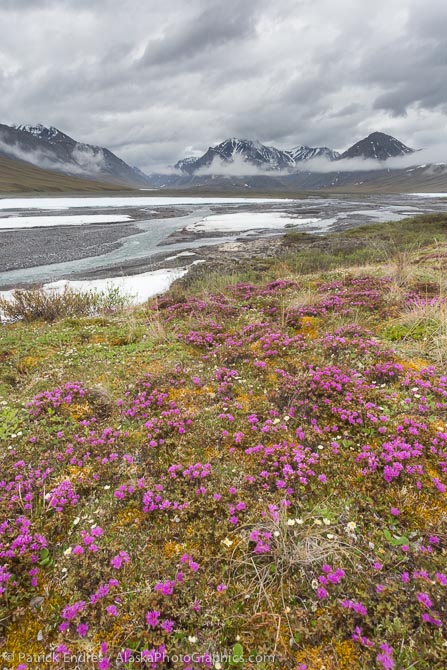Day 5, June 18, 2014, 34 miles packrafting the Ivishak River.
A 7-day, 170-mile wilderness backpack, and packraft trip along the Ribdon, Ivishak, and Sagavanirktok rivers in Alaska’s Brooks Range from June 14-20.
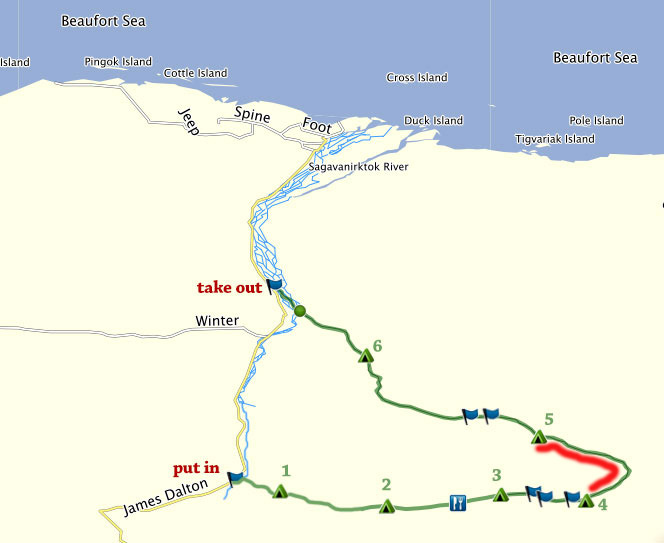
Day 5: Route Map, 1st day packrafting the Ivishak river.
The spring-blooming flowers beautifully colored our campsite on the tundra bench by the river. Namely Lapland rosebay, bright pink, and mountain aven, the ubiquitous blooming white flower found in early June.
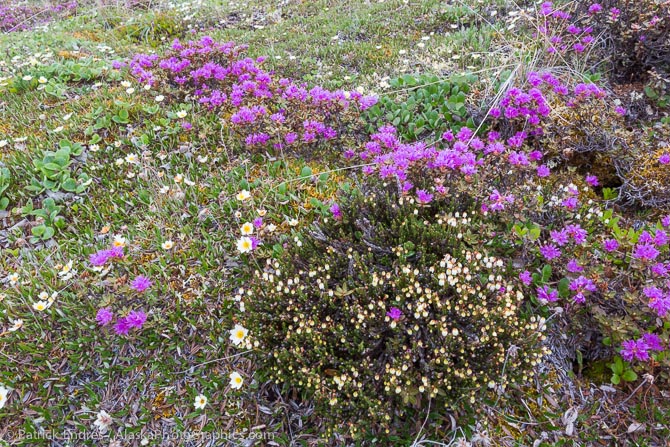
Lapland rosebay, mountain heather, and mountain aven decorate the tundra.
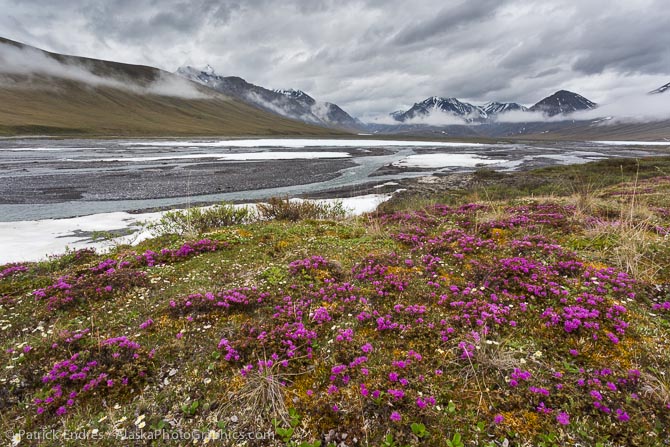
Spring wildflowers (Lapland rosebay) and the headwaters of the Ivishak river. Canon 5D Mark III, 17-50mm f/4L (19mm) 1/60 sec @ f/18, ISO 400
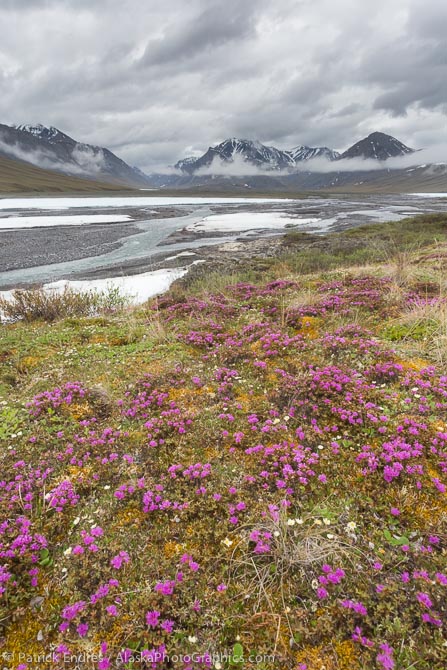
Spring wildflowers (Lapland rosebay) and the headwaters of the Ivishak river. Canon 5D Mark III, 17-50mm f/4L (21mm) 1/25 sec @ f/16, ISO 400
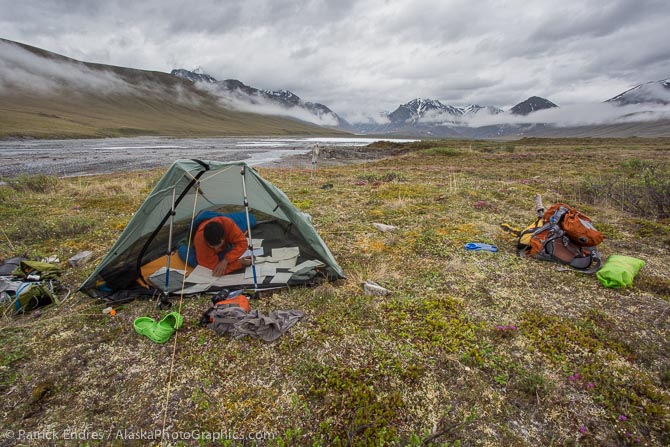
Camp on the morning of day 5. Mark reviews some topo maps in the tent before the day begins. A shift of weather arrived overnight, and hard rain and strong winds would start in a few hours.
Some light rain moved in during the night, and we woke to cloudy conditions. The rain had stopped a bit, which was a pleasant gift since breaking camp in the shower was no fun. Today would be the first day of packrafting the Ivishak river, so it was time to retool our gear and switch from our hiking clothes to our river gear. For me, that included Kokatak dry pants and an NRS dry top. I used that same system on a 30-day trip through the Grand Canyon, and it worked pretty well, although conditions were colder in Alaska’s Arctic. Mark had a one-piece dry suit from Alpacka Raft, made by Kokatat.
We had a relaxing morning and took our time breaking camp. By the time we got the rafts inflated, and our gear packed, it was about 1:00 pm, and the rain began as the clouds descended nearly to the river. It was great fun to hop in those rafts and start paddling–they are a unique little craft! Based on the bank levels, the water level seemed pretty high and clouded from the rain. The increased rainfall would make it even muddier over the next day. In the first few miles on the water, it was clear that this would not be a “float” trip. In other words, you don’t just sit in the raft and float down the river. Due to the many braided channels and shallow water, it required constant navigation and paddling. It was fun, and in a short while, we found a groove with the river and were having a blast. It can be extensive in some areas, and getting separated is something to avoid. We stayed pretty close together, alternating the lead. Getting stuck in shallow water is not a problem but slows you down and, more importantly, requires you to step out of the raft into that freezing river water.
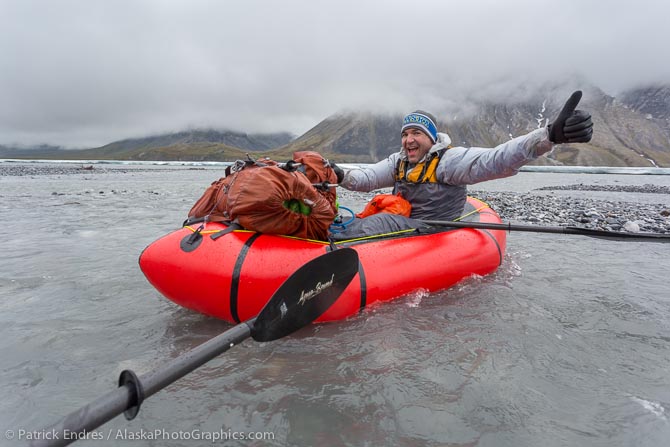
Those fantastic little packrafts! We attached our packs to the front of the raft with Alpacka Raft’s cord system. A lightweight, robust set of cords that is very easy to attach and release.
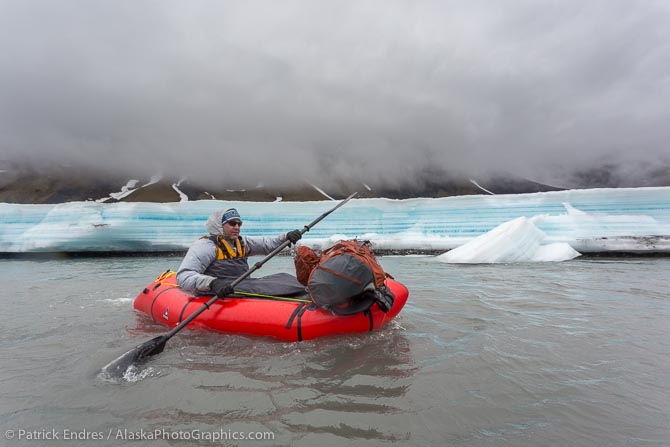
Mark paddles by some aufeis, clouds to the deck. I had to swallow hard to pass all this gorgeous mountain country without seeing the mountains I knew were there!
As we moved down the river, the rain and wind increased, making seeing and navigating challenging. The cardinal rule when engaging in performance activities is to stay well hydrated. Dehydration is the contributing culprit to many problems and injuries. It becomes harder to do in cold conditions when the process becomes less manageable. But the little Sawyer in-line water filter we used in our backpacks became very handy. I removed mine from the backpack bladder and stuck it in my lifejacket, where it was quickly accessible to drop into a clear part of river water and start drinking.
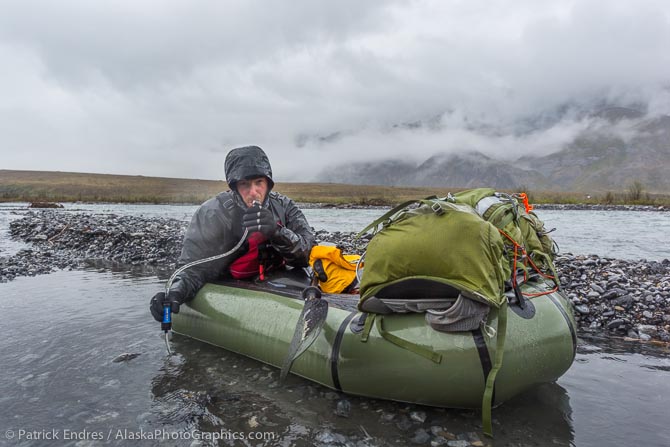
The Sawyer in-line mini filter worked great the whole trip.
The river water moved pretty quickly, and at a float speed, it was in the vicinity of 5-6mph. When paddling through quick-moving water, we reached 9-10mph speeds. The few questionable aspects of my river gear were for my hands and feet. Which indeed did turn out to be the weak points of my bag. The neoprene gloves were a total failure. They became giant sponges and did not serve me well in any regard. They are especially effective at transferring water to everything you touch, from disrobing to taking a leak to trying to use a camera. The next day, I switched to a dry interior glove with a waterproof mitten shell, which worked much better. As for the wet feet, I wore seal skin socks with my crocks, and in retrospect, a new pair of seal socks (the old ones were breaking down a bit) along with a thick liner would have been better. Warm feet (or at least tolerably cold feet) are beneficial for the photographer since, to take compelling photos, a different perspective is often desired, which requires getting out of the boat frequently in frigid water. Upon my return, I purchased the one-piece dry suit from Alpacka Raft called the Trekker, which comes with attachable dry booties. This will solve that problem for good on future trips.
We moved quickly down the river, and after about 20 miles, we paddled around a rock bluff by the river and were met with violent winds and pouring rain. It was raining hard enough that it was getting difficult to see in conjunction with the wind. We pulled out along a gravel bar, did some jumping jacks, and stuffed ourselves with food to warm up. We could measure our calorie load based on our energy and warmth. Once we were recharged, it was back on the river to find a good camp spot for the night. The photos start to get slim due to cold hands and a general focus on conserving heat and staying warm.
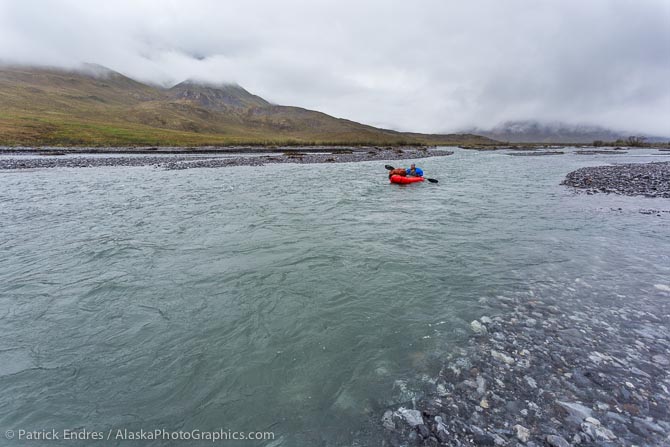
One of the few photos from our first day on the river before the heavy rains began.
We had planned to average about 30 miles a day on the river, and after 34 miles, we found a good camp spot, took out our rafts, and climbed up on a tundra bench to set up camp. After some hot food, we crawled into our very welcomed sleeping bags! Tomorrow would be an epic day on the water…

